Archive for ‘Motivation’ Category
Toxic Productivity In the Workplace and What Comes Next
WHAT IS TOXIC PRODUCTIVITY?
Productivity is a good thing, right? You’re hitting the goals you (or your team, or your boss) set, you’re working effectively (on the right things) and efficiently (zooming steadily toward your accomplishments). What could be bad?
Toxic productivity is when that drive to be productive is taken to unhealthy extremes. In a toxic work environment, employees lose motivation and self-esteem due to the external forces created by employer policies and/or management, as immediately recognizable in the now-classic Office Space.
However, toxic productivity can also stem from unhealthy expectations for what personal productivity should look like, and this can be driven by the workplace, by parental and educational influences since childhood, and even by genetic makeup.
Self-generated toxic productivity reads as workaholism, a drive not only to be productive at all times (and sometimes at all costs), but to appear productive at all times. In the past year, it has been called productivity dysmorphia, an expression which if not coined, was certainly popularized by Anna Codrea-Rado. (We’ll dig deeper into her article next time!)
Because it is the impulse for productivity as a process, rather than the achievement of the end result, that characterizes a sense of success, for someone suffering toxic productivity, there’s no sense of satisfaction. For the workaholic, there’s always an aching pit in the stomach that the end result could have been better or that they could have accomplished more. There’s no joy in crossing the finish line, because there’s always another finish line.
Those dealing with workplace-driven toxic productivity may fear losing seniority status or career security if productivity decreases. But for those whose identities are tied to what they have accomplished, self-esteem is often derived from getting stuff done, so it can be hard to find a personal off-switch. Work/life balance — a dubious concept in the first place — is hard to achieve when you identify your value in life by what you achieve at work.
For those whose identities are tied to what they have accomplished, self-esteem is often derived from getting stuff done, so it can be hard to find a personal off-switch. Share on XAre you asking, “What’s the problem?” Focusing on productivity means high achievement, and if your sense of self is measured by what you achieve, how will you ever get off that roller coaster? How will you ever stop chasing the high of “having done the thing” you set out to do? When do you get to breathe?
If you always feel that you should be getting more done, you may feel guilty when you’re not producing — and this can include needing that sense of accomplishment through housework, hobbies, or any competitive impulse where the drive eclipses the enjoyment.
If you feel more and more worn out rather than energized by whatever you do, that’s toxic. And like any poison, it will drain you of your vitality.
An obsession with productivity can not only lead to a lack of productivity, but can eventually cause leisure sickness, where during your downtime, with family, or while on vacation, you’re unable to relax and enjoy the moment, as you may become disconnected from the idea of existing without working toward a productive end.
Today’s post is going to focus on toxic productivity in the workplace, and what’s being done to countermand it. Next week, we’re going to dig deeper and look at how we can target toxic productivity and productivity dysmorphia at the individual and societal levels to be productivite in a more healthy way.
TOXIC PRODUCTIVITY AROUND THE WORLD
Have you ever heard of 996? China made the news last year because many workers were on a 996 schedule, working 9 a.m. to 9 p.m., six days a week!
Meanwhile, in Japan, there’s a corporate culture that leads to workers performing up to 80 hours of overtime, often unpaid, each month. It’s called Karōshi, “death by overwork,” and it’s marked by an extreme performance of company loyalty, both on and off the clock. Employees, legally granted twenty vacation days per year, regularly fail to take half of them.
For what it’s worth, this overwork doesn’t help Japan’s productivity, which falls behind the United States, France, Germany, Italy, the UK, and Canada.
Lest you think that this is only a problem in the Far East, be assured that this kind of toxic productivity is alive and not-so-well right here in the United States. For example, according to Project Time Off, in 2016, 55% of Americans did not use all of their paid time off. That’s 658 million unused vacation days, one-third of which did not roll over to the next calendar year or get reimbursed financially. Poof. That time off just disappeared, and the dollar value of that time went into company coffers.
In 2019, the last pre-pandemic year on record, 768 million vacation days went unused — and less than a quarter of Americans used all of their available paid vacation! Oddly, a 2019 study showed that one in three Americans would be willing to take a cut in pay in order to get unlimited vacation days. This is pretty puzzling. Workers want more vacation, but they’re unwilling or unable to take all of the paid days they have!
Why might this be? A recent TikTok (sigh, yes, I’ve become one of those people) showed an imagined conversation. A representative of Human Resources was cheerleading the advent of summer work hours, where staff would be allowed to leave at 3 p.m. on Fridays. Dubious, the worker asked if workload expectations would be scaled back accordingly.
The “boss” character noted that staff would be encouraged to work late on Thursday evenings to make up the workload. After the employee pointed out the irony, the boss character noted that, simply put, they wanted both the same level of productivity and credit for offering work/life balance.
The grim humor aside, this is the reality for most workers, and it’s not just about vacation hours. More and more, I’m seeing articles about “sad desk salads,” popularized by the Jessica Grosse novel of the same name.
From Life Is Too Short for Work Salad to The “Sad Desk Lunch” is Now Even More Depressing as Employees Return to the Pandemic-Era Office to this older (not-entirely-comedic) video, Sad Desk Lunch: Is This How You Want to Die?, the toxic drive for productivity (or to appear productive) is dangerous.
The problem isn’t salad, but dining at one’s desk while continuing to work through lunch. We know the continued sitting is bad for physical health. The lack of socializing (even for introverts) and inability to take cognitive breaks from labor (and physical breaks from the workplace to get fresh air) are bad for mental health.
None of this is new. Workers’ fears of being replaceable and the corporate message of being a “company man” or “company woman” have been around for a long while. And now, there’s an overwhelming uncertainty as we struggle through a third summer of COVID and into inflation and a prospective recession. (Sorry, this isn’t the usual chirpy Paper Doll topic!)
Of course, if there’s been one positive of the these past 2 1/2 years, it’s that workers are no longer willing to be taken advantage of. I’m sure you’ve noticed that there are fewer cashier lanes open in stores, and most restaurants have signs on the front door, warning patrons that they are short-staffed. While I don’t want to get political, I completely agree with this tweet:
Periodic reminder: there is no labor shortage. There is a shortage of jobs that treat workers with dignity and an excess of corporate greed.
— Robert Reich (@RBReich) June 10, 2022
CONQUERING TOXIC PRODUCTIVITY FROM THE TOP DOWN
The tweet’s point is apt, but the question becomes, how can we maintain healthy productivity in the face of corporate greed?
In the middle of the 20th century, that was a role filled by unions. Now, productivity will be controlled in three ways: by governments setting policies for the betterment of society, by companies recognizing their long-term self-interest in treating employees better, and by individuals either working from within to change company culture or leaving for different workplaces or starting their own businesses.
(Full disclosure: A little more than twenty years ago, I left a toxic industry, and a particularly toxic workplace, and became a professional organizer. The impact on my physical and mental health was an absolute net positive. But, of course, becoming self-employed is not a panacea for everyone, as we’ll discuss in greater detail in next week’s post.)
Japanese efforts to counter Karōshi were iffy at best; they mandated that employees took their vacation days and set corporate office lights on timers to go off at 10 p.m. And, like the TikTok example, they shortened work hours on the last Friday of some months, but it turns out this was more of a marketing effort to get workers to use their off hours to shop!
So what might actually work?
Curtailed Office Hours and Remote Work
You may have seen on the news last week that 70 companies of varying sizes, from mom-and-pop restaurants to corporate entities, in the United Kingdom are testing 4-day workweeks this summer. Like the TikTok example with a token carving away of two hours, these blue-collar and white-collar workers will be paid for their usual (generally, 40) hours per week, but will only have to show up for 80% (so, generally 32 hours); in most cases, the same level of productivity will be expected.
On the one hand, this will give parents the opportunity spend more time with their children, and all workers the chance to make medical appointments and attend to other life necessities. On the other hand, if workers are on-site (whether in offices, restaurants, or stores), they’ll lack the appealing flexibility of work-from-home jobs that became so popular during the earlier stages of the pandemic.
And the research does overwhelmingly show that WFH office workers did not need micromanaging and were as, or more, productive than when they were in the office. Indeed, an Owl Labs study found that, “On average, those who work from home spend 10 minutes less a day being unproductive, work one more day a week, and are 47% more productive.”
That said, there are people who missed the camaraderie of the office and the transitional headspace of commutes. Remote work is one way to improve working satisfaction and defuse the toxic productivity bomb, but it isn’t a solution for everyone.
Better Work/Life Boundary Expectations
In 2016, France took a different approach. Recognizing that the digital, always-on era means that office employees can’t achieve “work/life balance” if there’s increasingly little daylight between their “work obligations” and their actual lives. So, France amended its labor laws such that in any company of 50 employees or more, you cannot email an employee after official work hours.
BOOM!

French Café Photo by Stephanie LeBlanc on Unsplash
Imagine leaving work, going to a café, and not having to be bothered about work until the next workday!
This “right to disconnect” rule isn’t the only thing France has done to improve quality of life. All workers get 30 paid vacation days a year and 16 weeks of fully paid family leave. For comparison, the United States has no nationally guaranteed paid vacation policy and no national policy guaranteeing any paid family leave. Just saying.
Oh, and in case you didn’t make it to 1:48 into the video at the top of this post, France is second only to the US in terms of productivity (GDP per hour worked).
A year after France created this right to disconnect, Italy did the same, and then Spain! In 2018, Belgium followed suit, announcing that 65,000 federal civil servants would no longer have to answer calls or emails from their bosses outside of working hours. Portugal passed a labor code banning employers from pestering employees during their “rest period” except for emergencies, and this applies to both office workers and remote workers. Managers who breach the policy can be fined!
Oh, and last year? Ireland instituted a right to disconnect rule applying to all employees. Your boss can’t contact you by email, phone, or text during your off hours.
Does your workplace (or nation) have any policies that ameliorate the tendency toward toxicity? Please share in the comments, below.
Next week, we’re going to continue this series by delving more deeply into what we, individually, can do to shut down personal tendencies toward toxic productivity and reverse productivity dysmorphia. We will examine:
- Healthy productivity strategies
- Ways to unplug from work and from a sense of obligation to do rather than just be
- Beneficial habits and routines
- A reading list for seeing yourself, and what you accomplish, in a more wholesome way.
Paper Doll Interviews Life Coach, Author, and Kid-Schlepper Allison Task
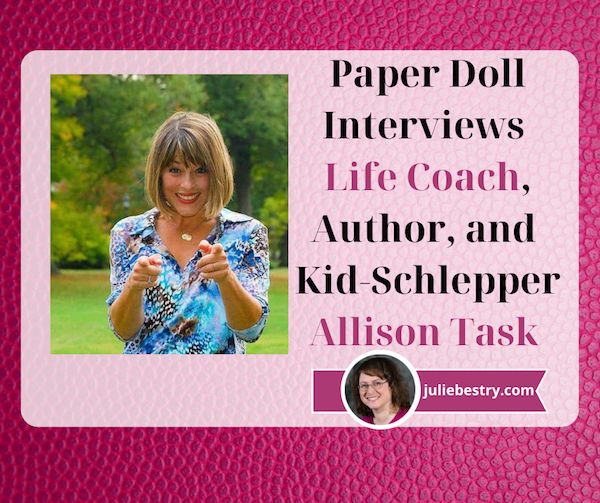
Paper Doll readers know it’s a rarity for me to do interview posts. I’ve saved this feature for special topics and colleagues, like Melissa Gratias, Leslie Josel, and that fun group of genealogy organizers, Janine Adams, Jennifer Lava, and Hazel Thornton.
Today, I want to introduce you to life coach Allison Task. You’ll hear how experiencing misogyny, learning psychology, the dot-com boom, culinary school, Martha Stewart, and de-prioritizing social media have helped her organize a life that allows her to support her clients, her readers, and her kids (who have a lot of their own adventures going on).

I’d like to say I knew a lot about Allison before she presented Let’s Make a Shidduch! How to Match Your Strengths to Client Needs and Do More of the Work You Love at NAPO2019 (especially as it turns out we went to the same college). But the shallow truth was, I picked her session because I was intrigued “shidduch” (Yiddish for “match,” as in matchmaking) and then was transfixed by the cool dress she wore during her presentation.
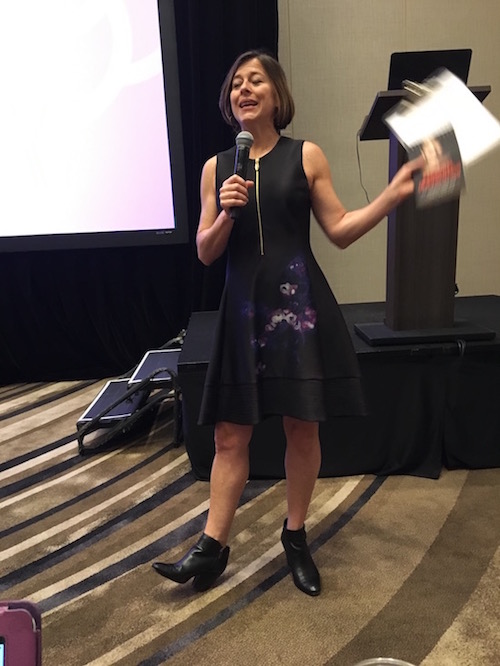
Had I known I’d be writing this post two and a half years later, I’d have been careful to take better photos! In my defense, Allison is such a high-energy presenter, there’s no way I could have caught her when she wasn’t in motion. So, I’m particularly excited that she was able to sit down for this fun interview about how she became the powerhouse life coach, speaker, and author she is today.
Allison, although we met at the NAPO Conference in Fort Worth, Texas, we *almost* could have met at college. I graduated from Cornell University in 1989, and you arrived just a little later, finishing in 1994. Mine was the decade of big hair and oversized sweaters; yours was the era of Beverly Hills, 90210 (the original!), babydoll dresses, and flannel shirts.
Could you tell Paper Doll readers about your early life and college years (when you majored in Human Development and Family Studies at Cornell, and later got a Masters in Science in Food and Nutrition from New York University)? What did you plan to do when you finished school?
But really, which one of us was Gear bags? Neon pinstripe jeans? NafNaf and ID#? I mean, Aqua Net belongs to the ages, but I am going to claim Sir Mix-A-Lots “I Like Big BUTTS” refrain as central to my college experience. Sigh. I just know I wore a lot of unitards and boot cut jeans under that flannel…
[Editor’s Note: As much as I love to link to pop culture videos, readers are just going to have to click through if they want to sing and dance along to Baby Got Back. It’s still a little spicy for an organizing blog!]
I think one thing that was key to college, or at least my interests during that time, was that I wanted to help people. And I was obsessed with how we think, why we think, and how we make the choices we make. Growing up as a girl on Long Island in the 80s, my experience was that we were coached to be lemmings — go to the mall, get your face on, and attract a male.
I really felt like my experience as a smart girl in the 80s was [being told] to tone it down, diminish the smarts so you didn’t alienate the boys. Your value is the boy you attract. I repeat, your value is the boy you attract. So I read the magazines and did the things to be, well…visions of Cherry Pie and Aerosmith videos. I think of the 80s hypersexualized women and girls, and those were the messages I received about women’s and girls’ worth.
At college, there was a refrain that we were the “ugliest girls in the Ivies.” [Editor’s note: Not Allison or I, personally. Just to be clear. We were stunning!]
And we heard that “smart girls are, obviously, dogs.” I remember the word dogs being used instead of women. So, I have a bit of baggage. When Supreme Court Justice Brett Kavanaugh’s hearings were going on, I watched every one. My phone line was lit up with friends at Yale who went there when he did. Those stories about high school parties and bad behavior led to similar in college. Similar but worse. And my college experience was full of experiences like those that Dr. Christine Blasey Ford revealed. Both experientially, and watching very drunk girls get carried away into rooms for terrible abuse. I saw and experienced things I wish I didn’t, and got both campus police and [the campus newspaper] involved. Let’s just say the male authorities didn’t want to touch any of that stuff.
It’s a different time today and I’m grateful for it. But it’s hard not to remember college without those experiences pushing to the fore.
I went to school because I wanted to learn more about people and how they think. Thus, Human Development. As I saw it, after I received my degree, I could go into marketing or social work. Since social work required more schooling, and seemed a bit grim and underpaid from the stories I heard from HDFS grads, I pursued marketing.
And media. In fact, my first job after college was a paid internship with WNET (Channel 13) in NYC. I was to research a documentary about celebrating the differences between the sexes. Gosh, flash forward to years later and this would be a totally different subject!
On Day 1, the funding fell through and I was researching a documentary on Hoboken. After the award-winning producer brought me to his apartment in Hoboken a few times and made me feel horribly uncomfortable (Picking up on a theme here? I hope so!), I quit and waitressed at my local pasta joint. What a summer!
Yikes! So what then?
Then I got a job as a CD-ROM CEO’s secretary, and had the job of researching how they could build a web site.
This is how my career launched. A year later, I was working at an Internet startup, and a year after that was recruited by CNET in San Francisco to join their team. A year after that, I was working for another startup and my starting salary was more than my mother’s final salary before she retired as a principal. I share that to let you know what a head trip this all was — I was three years out of school with a Human Development degree making more than my mother did as a principal in the highest paying district in New York state. Bananas!
I worked at dot coms for the better part of 10 years. I had a front row seat to the internet revolution in the nineties and aughts and it was a blast. I had the most exhilarating conversations about what we can build, and work and life happily blurred. The conversations I had about possibility, and what might happen (“Imagine, some day we will do holiday shopping online! Really, we will!”), dodging the naysayers, believing and building — all set the groundwork for the kind of creatively inspired conversations I have with my clients every day as a coach.
I eventually left dot coms and went to culinary school. After ten years of digital, moving from NY to SF and back again, I was ready for something more tangible and tactile. It’s no mistake that the maker movement has come in concert with the rise of digitalization — they are yin and yang, and I needed more yang.
Also, the B-school folk rushed into the dot-com world and made it all about bottom lines. There was more than enough money for everyone, but the obsessive focus on “exploiting the market” turned me off and felt grotesque. When we moved from the creative question of “what can we build” to “how much money can we make” I got bored and went to share my talents elsewhere.
(The Food Science Masters at NYU happened in my late 30s and was more for fun than a direct part of my career path.)
OK, so basically, you did the dot.com thing until late-stage capitalism turned the joy of creation into something unpalatable, then went to culinary school where everything was (hopefully) palatable! And (like me, before I was Paper Doll) you spent time in the television industry. The word is that you even worked with THE Martha Stewart!
All true! When I went to culinary school, I had a specific goal: I wanted to help people learn to cook at home. We grew up with the first generation of working moms and microwave dinner. I wanted to return the skill of home cooking to full time workers, and make it fun and easy. But not microwave easy, 20-30 minute puttanesca easy. I had put on some weight eating out all the time when I was dot-comming, but more importantly, I couldn’t hard boil an egg. I wanted to learn and I wanted to teach.
And the best home cooking teacher at the time, or at least the most visible, was Martha Stewart. And I needed to work for her. So I pursued and pursued until I had the opportunity. I was part of the launch team for Everyday Food, and eventually ended up as a culinary producer for her TV show.
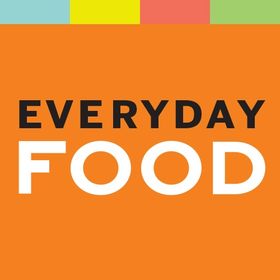
I learned more there than I had hoped — and was able to work directly with Martha. Presenting a TV segment to her is like defending a thesis. You have to think through everything. It raised my standards in the highest possible way.
While there, Martha was under investigation (and I left when she was sentenced to prison). As a result, the company was looking for talent inside the organization. I was asked to audition for a TV show, and ended up testing really well. (I was told I got very high “Q” ratings.) [Editor’s Note: Q scores measure familiarity and appeal of personalities and brands.)
So they media-trained me and gave me an opportunity to be part of the Everyday Food TV show on…PBS! Channel 13! Ah the irony of returning to that place of abuse as TALENT!
That was my first TV opportunity and it was a blast. Pure fun. After that I had opportunities to host shows on TLC, Lifetime, and Yahoo. An early producer gave me the advice, “Don’t count on this as a career, just have fun with it as long as you can.” I did and it was a blast.
How did these experiences prepare you for a career as a life coach, speaker, and published author? (And anything you want to say about Martha?)
Martha is great. She is endlessly curious and pursues those curiosities with vigor. I admire her tremendously.
I had twists and turns in my career. I knew what I wanted to do — help people, understand why they do what they do, and help them do the things they want / that benefit them. As a dot-com marketer, I helped explain what the internet could be. I helped people open their minds to the possibility of creating businesses online. It’s a leap of faith to show people the future, and to help them dream in this new environment.
That’s exactly what I do as a coach!
I get it! That’s what we do as professional organizers!
When the dot com became too exploitative or materialistic, I was turned off and looked for different work.
Working on TV helped me understand mechanics of communication — how I could interact with people to produce an emotion, and how sometimes helping people have a good cry could be beneficial to them. I learned how to connect with guests on my shows to set them at ease (while cameras were rolling), and build trust. These are absolutely skills I use with clients today (without cameras).
I trained as an early dot-commer to imagine the possible, and I trained as an on-camera host to build relationships with guests on the show and with my audience.
Working as an author I tried to share my personality / point of view to entertain and educate.
I was never very good at or interested in social media and all the self promotion (or all the hours of liking and engagement that it requires). I sidelined myself from media work when that all got big, in part because I had three kids in a little less than 1-1/2 years and I wanted to put my focus on them, not Facebook or Instagram.
This hurt me, I’m sure, in terms of my public image, but I’m quite happy about the connection I have with my kids and our light media engagement. I made the better choice personally, and it’s part of why my public image is rather quiet.
What would you say was the turning point that helped you identify your true calling and fine-tune what you do professionally?
So many moments! Here are three key ones:
- When I became a paper millionaire at my dot com at 26, I decided that was enough money to not have to work again. I wanted to live light, and I could live off the investment (not touching the principal). This opened the question of what work I would do if I didn’t have to work, which led me to helping people, helping their physical health, which led to cooking.
- Getting that Q rating at Martha developed my confidence that “people liked me, they really liked me,” and if I was true to my personality, that could resonate in the market place. I didn’t have to Aqua-Net my way into the favor of the public, I just had to reveal who I actually was. That was the special sauce!
- I was on the back of my boyfriend’s Triumph, tooling around NYC, and stopped near NYU to get some noodles. I picked up a copy of the NYU Steinhardt course catalog and saw the program for coaching. Lightning bolt moment — I could help people raise their game, work better than they are currently doing, enjoy life more. Sign. Me. The. Hell. Up! It was so clear that I had to do this, like the tide lifted me and I had to do it.
What do you love about the coaching experience? What are some things that have surprised you about coaching?
I love my clients. I love their bravery and courage to ask for more in their lives. I love our relationship, how we create a sense of trust and how I help them do what they know they want to do! I like supporting others to their own personal greatness.
I do get sad, sometimes, at the distance that is created culturally that we get so far from our own voice, that we stop listening to ourselves. I love the repair that can happen inside a person — that they can start to believe in and trust themselves again.
I love listening to another person really deeply so that they can better listen to themselves.
I like laughing and having fun with a client. There’s a big range of emotions — fear, sadness, hope, pain, joy…it’s powerful.
Writing is obviously a passion for you. Even before you were a coach, you made a name for yourself in writing cookbooks. There’s You Can Trust a Skinny Cook (as Allison Fishman) and Cooking Light’s Lighten Up, America!: Favorite American Foods Made Guilt-Free (under your full name, Allison Fishman Task).
Flow and Faux (Accountability): Productivity, Focus, and Alex Trebek
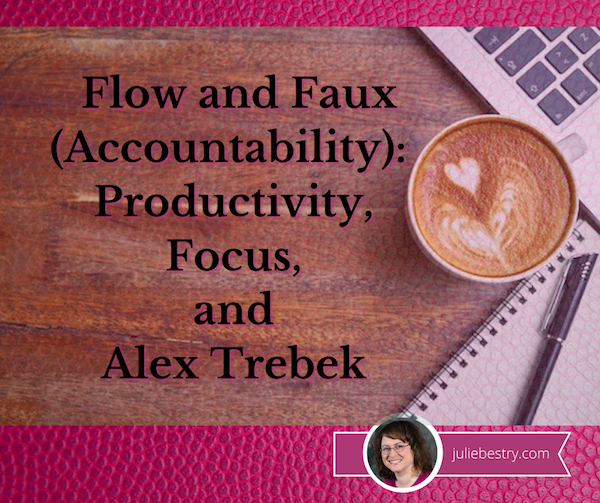
Image by Engin Akyurt from Pixabay
Last week, in Count on Accountability: 5 Productivity Support Solutions, I presented five methods for getting accountability:
- accountability partners, like friends, colleagues, or people you can meet through apps like Supporti or Focusmate
- accountability groups, like mastermind groups, in-person study groups, virtual study groups like Hours, and professional groups
- professionals, including professional organizers, life coaches, and fitness trainers
- apps and gadgets, including StickK, Beeminder, the saucily-named (and partially redacted) Go F***ing Do It, and Pavlok
- events, whether DIYed, sponsored by a specific entity (like Deb Lee’s periodic Action Days), or “work gyms” like Caveday or Ultraworking
Across the various social networks, this post garnered quite a bit of conversation about what accountability methods worked for different people and for different activities.
Then, from Thursday through Saturday, I participated in the Task Management & Time Blocking Virtual Summit 2021, with so many of my all-star colleagues from NAPO and the productivity world, as well as big names and some surprising up-and-comers. (In an forthcoming post, you’ll be hearing about a group of talented young people surpassing all expectations in developing a task management solution. Spoilers!)
At the summit, during the online networking, a conversation among attendees sprung up regarding an accountability concern I hadn’t considered. While some mentioned that they were introverts, even the extroverts shared similar thoughts: they were intrigued by the accountability options I’d mentioned, but at least sometimes, they didn’t want to deal with other people!
WE’RE ZOOM-WEARY
I suspect the pandemic has simultaneously made us wary of other humans and weary of digital communication. After all, Zoom Fatigue (and Meet Fatigue, and Facetime Fatigue) is real:
Four Causes of Zoom Fatigue and Their Solutions (Stanford University)
Zoom Fatigue Isn’t Just a Buzzy Term: 4 Common Causes and Fixes (MindBodyGreen)
Four Reasons You’re Tired of Zoom Calls and What To Do About It (Washington Post)
Zoom Fatigue Cartoon (Marketoonist)
Zoom-weary lawyer via GIPHY
To all the common causes mentioned, I’ll add that our voices and our lungs are doing unrealized extra effort. When you’re in a conference room or office with someone, you have a sense of the room’s acoustics; you know when you’re being too loud or too quiet, and other people’s reactions will alert you to that fact. (Fear you’re too loud on your phone at your desk? Look around the room – if people are looking at you and then their eyes dart away, then shush! We don’t treat overheard conversations like radio, but like TV, and turn toward it.) On the phone, we also have a sense of how to modulate our voices properly.
But virtually? With people using computer microphones, ear buds, headsets, Bluetooth podcasting mics, and more, volume varies. We’re all self-conscious, uncertain about how we sound. When we get excited, we lift our voices (and may breathe heavier and more deeply) because the chasm between ourselves and the faces on the “black mirrors” in front of us make us feel like we’re shouting across miles.
“But Paper Doll,” you ask, “what does Zoom Fatigue have to do with productivity?”
ACCOUNTABILITY’S DISTRACTIBILITY PROBLEM
Right. Yes. Back at the virtual summit, what these people really liked about the idea of accountability events was feeling like they were working among others. But even though they wanted that feeling of being back in the office again, having some camaraderie, they were vocal about what they did NOT want:
- to feel observed while they were working
- to feel the need to be social (even though accountability events, work gyms, and even virtual co-working partnerships are supposed to limit the chitchat)
- to have to do their hair or makeup or put on semi-grownup clothes
- to feel judged
- to be distracted by the other people’s homes or offices, better hair, or virtual backgrounds (One woman said that if she ended up with a virtual accountability partner who was too attractive, she’d be too self-conscious to focus, recalling memories of 10th grade study hall.)
My response in these conversations developed over a few days. At first, I joked that maybe setting up children’s stuffed animals across the table, as if for a tea party, might approximate the body doubling phenomenon we discussed last week.
But then I realized that the problem with that solution (even once you get past the suspension of disbelief) is that there’s no apparent feeling of humanity. Body doubling and most actual accountability methods involve at least some minimal interaction, even if it’s just a virtual handshake preceding getting down to business.
But maybe it doesn’t always have to be the ability to SEE someone doing something. Maybe hearing somebody doing something might be enough to help us focus and concentrate?
SIDEBAR ON FLOW AND THE UNPRONOUNCEABLE MIHALY CSIKSZENTMIHALYI
You’ve probably heard about flow, a state of concentration or complete absorption with the activity at hand and the situation. You know – when you’re in the zone. The concept was popularized by Mihaly Csikszentmihalyi, in his book Flow: The Psychology of Optimal Experience.
The key idea of flow underpins everything we attempt in the productivity realm, from Cal Newport’s “deep work” to our Pomodoro Technique efforts. When we’re distracted by our own thoughts and worries, or the neighbor’s leaf blower, or an office-mate who chews his gum with his mouth open, it’s hard to get into flow. However, flow is what we need most. Hear about in the man’s own words:
If you had any trouble getting into flow with that talk, check out Fight Mediocrity’s animated book review of Flow and PositivePsychology.com’s deep dive into 8 Ways to Create Flow According to Mihaly Csikszentmihalyi.
Oh, and that unpronounceable name? If you can say this: “Me? Hi! Chick sent me. Hi!” then you can say his name. (You’re welcome.)
FAUX ACCOUNTABILITY FOR FLOW
So, if seeing other people in an unnatural co-working or accountability setting will be distracting, what about only hearing other people? And in particular, hearing them but having them not being able to hear you? And NOT having the kind of distractibility that comes from unintentional eavesdropping?

These summit discussions kept reminding me of my blog post, 11 Ways To Organize Your Focus With Ambient Noise. After six and a half years, this has proven to be one of my most popular posts. People really embraced the ideas of white (and brown, and pink) noise, and how soothing sounds enable you to get into flow.
Most of the neuroscience-approved solutions I provided were either nature sounds, like babbling brooks, rain, wind, etc., or similarly non-human sounds, like crackling fireplaces, showers, or washing machines. But a few of my suggestions had included background sounds that were not found in nature, but in the public realm, and in the past year, as people have missed going to coffee houses, bars, and yes, even the office, auditory “virtual happy places” have grown in popularity.
This is why I call it “faux” accountability. There’s none of that key accountability where you tell someone else what you need to work on and honor that externalized obligation to yourself; this is more like the general sense that when you’ve taken your work to a coffee shop, you’re counting on generating that flow state, getting yourself into the zone, and working. Out in the real world (of yore), you counted on a more implied sense of accountability.
You don’t tell the barista or the guy at the next table that you’re a serious person doing serious work writing a serious blog. But you buy your coffee to get the WiFi code, you sit at the table nearest the outlet so you can keep your laptop charged, and you get to work knowing that all those strangers (who really aren’t thinking about you at all, unless you’re hogging the outlet) are expecting you to GET. STUFF. DONE!
So, I posit, what if you could get that same feeling virtually?
Coffitivity
Coffitivity was the first browser-based site of its kind to hit the mainstream. Based on research by Ravi Mehta, Rui (Juliet) Zhu and Amar Cheema in Is Noise Always Bad? Exploring the Effects of Ambient Noise on Creative Cognition, and published in the Journal of Consumer Research, Coffitivity took the idea that “a moderate level of ambient noise is conducive to creative cognition” and ran with it. There are three free soundtracks in the cafe library:
- Morning Murmur – “a gentle hum gets the day going”
- Lunchtime Lounge – “busting chatter of the lunchtime rush”
- University Undertones – “the scholarly sounds of a campus cafe”
For $9/month, you can upgrade to premium level and access:
- Paris Paradise – “energizing ambiance from the City of Light”
- Brazil Bistro – “the musical chatter of a Brazilian coffeehouse”
- Texas Teahouse – “hefty sounds from a big state”
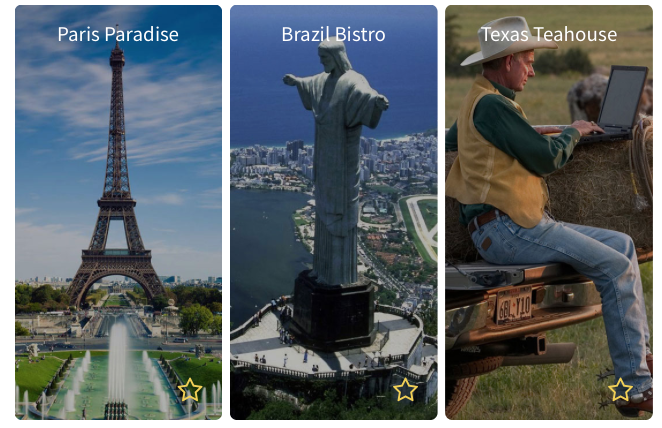
Coffitivity also has a friendly blog written with cognitive, financial, and social needs of freelancers, solopreneurs, and remote workers in mind.
Although Coffitivity is browser-based, there’s a MacOS desktop app if you want to run it when you’re offline.
HipsterSound
HipsterSound’s Cafe Vibes has three public audio tracks: the buzz of a busy Texas cafe, Les Charmants Cafés de Paris, and the gentle hum of a quiet restaurant. In addition, at the premium level, there’s the gentle chatter of a Danish restaurant, the bustling vibe of a Rio de Janiero restaurant, the animated buzz of a cafeteria, a lively library ambiance, and an advanced rain simulator.
In addition, you can toggle on/off a variety of other sounds, including a desk fan, a co-worker’s typing, nature sounds, and different venue noises (a jazz club, an open-air bistro) and listen to any combination of those sounds on their own OR combined with the cafe and restaurant audio tracks.

Because I didn’t pony up the $2/month (though you can pay less if you get a one-year subscription), I couldn’t listen in on the foreign language options. In general, though, none of the voices on these kinds of apps can be discerned enough to be distracting. After a year of lockdown, it might be a relief to do your work in Copenhagen or Rio!
Use HipsterSounds in your browser or via the Android app.
Cafe Restaurant, Calm Office and myNoise Development
Cafe Restaurant, from myNoise, which I included in my original post about ambient noise, looks much the same but has expanded its offerings. It still lets you use the sliders to adjust audio element styles that include the “levels” of Rumble, Restaurant, Chatter, two separate levels for Babble, Mess, Cafeteria, Cafe, Table, and Kitchen. You can now increase or decrease the speed of the soundtracks, and they’ve added both a meditation bell and a timer, useful for those who wish to implement the Pomodoro Technique.
One of the newer sibling ambient soundtracks that might be perfect for remote workers looking to simulate that soothing office hum is Calm Office.
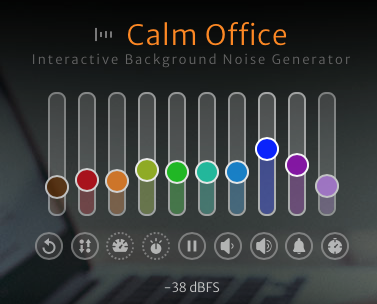
The adjustable sliders in this app include room tone, air conditioning (which, like in a real office, seems to lean toward the overpowering, (unintelligible) chatty colleagues, copy machine, printer and scanner, blended generic office noises, keyboard and mouse clicks, pen on paper, and a loudly ticking “office clock” noise.
myNoise has added a number of other related ambient environments you might want to add to your productivity arsenal:
- Catholic Church – adjustable levels are available for rain and thunder, two kinds of bells, an organ, two kinds of whispers, footsteps, random people noises, and the hushed voice of a priest. In college, I would sometimes do homework in the vestibule of a church while my friend attended Saturday evening Mass, and I can attest to the fact that (for this Jewish girl, at least), it made for a very calming background noise. I can imagine, however, that many other religious services might have a bit too much energetic verve to (sacrilegiously?) use as background noise.
- Mexico City – as part of a developing series of global cities, this option includes busy streets and traffic noises, the Mercado Coyoacan (market), mariachis, trompetistas, protests and police sirens, and birds. While it seems like it would be hard to get into flow with this atmosphere, to each one’s own.
- Night Commute – for those who miss the creative inspiration or flow state of their nightly drive or ride, this option does not offer up traffic noises, subway doors closing, or anything similar. Rather, it’s a mix of jazzy music that reminds me more of a movie montage of a commute than an actual commute.
The myNoise mixable soundtracks are available for the browser and in an iOS app; there’s an Android version, as well, but in the past seven years, myNoise has remained dissatisfied with ongoing Android problems and recommends Android users listen via mobile browsers.
Magical Tearoom
For something really simple, look no further than the Magical Tearoom. There are no pre-sets, no toggles, no sliders. There are no options at all. It’s just an eight-hour YouTube video with the cozy sounds of an old-fashioned tearoom, paired with a vaguely Eastern setting. The hot water periodically gets replenished, the tea leaves float, the steam rises, and other satisfied visitors burble unintelligibly, creating a calming, peaceful space for focusing on your work.
While one is left to assume that the “magic” comes from the sparkly bits flecked across the screen like so much pixie dust, I’ve found something else. In general, I need my white/pink/brown noise to be devoid of human sounds, so what’s magical to me here is that the atmosphere feels the most natural and the easiest to settle into. I’ve written much of this post “in” the Magical Tearoom.
I’d encourage you to check out the many other sound collections from this creator, Miracle Forest. Those tend to be shorter, about two hours in length (suitable for four Pomodoros, with breaks), and have themes, like a Hogwarts-inspired rainy Castle Reading Nook or Study Session at Night.
Sounds of Colleagues
Sounds of Colleagues is the result of a creative collaboration between Familjen STHLM, a Swedish advertising agency, and Red Pipe Studios, an audio branding agency. When Sweden locked down and offices closed, employees at both really missed their peeps, giving rise to this simple page.

Use the sliders to raise or lower the levels of sounds of the general room tone, the coffee machine (likely nicer than what you had in your office), co-workers, printer, rain on the window, keyboards, sounds outside the open office window (including car horns and traffic). There’s also an alternatingly barky and whimpering office dog (and an occasional, whispered “good boy!”) and a ringing telephone. I urge you to turn the telephone sound down all the way, as the virtual phone is as annoyingly distracting as it is in real life.
If you miss your office, and maybe even the people in it, this is the most pleasantly realistic. For deep work, I suggest using the browser version works as I’ve described. However, if you prefer variety, on Spotify, you can listen to a playlist of short 2-5 minute tracks, with titles like “Corporate Office in the Middle of the City,” “90s Office With Landlines Ringing” (don’t – just don’t), and “Cocktails and Typewriters Anno 1960.” (There’s that Mad Men theme again!)
I Miss My Bar
Maybe you’re more of a Hemingway (“Write drunk. Edit sober.”) person, and you’d get more flow and accountability and less distraction in a bar than a coffee house or office?
Maybe you're more of a Hemingway ('Write drunk. Edit sober.') person, and you'd get more flow and accountability and less distraction in a bar than a coffee house or office? Share on XViral sensation I Miss My Bar has you covered. Maverick, a jazzy bar/restaurant in Monterrey, Mexico, had to close during the pandemic, but created this platform, leaving the following message:
We all miss our bar.
Hanging out with friends, deep conversations over Gin & Tonics, meeting great new people, the atmosphere.
Even though these things will never be replaced, at Maverick we’ve made this modern digital artifact to keep you company while this awful pandemic, which profoundly affects our industry throughout the world, finally passes and we can meet again safely.
Plug your device to a decent speaker set and use it as a background sound for your zoom parties, or just for your daily wind down cocktail at home.
As every hospitality professional in the world we, too, miss you as well. If you are feeling generous, try to find a way to support your favourite local bar staff today. You can support ours here.

Get into your work groove while listening to the weekly music playlist; use the sliders to adjust the sounds of a bartender mixing drinks, a full-room crowd, rain on the window, night ambiance (in case you’re on the bar’s back deck), street noises, and drinks being served.
To get a sense of the Maverick bar’s actual ambience and menu, here’s a translated version of their website. I suspect, when the world tips back enough toward the old ways, Maverick will have a lot of real-world visitors.
AN ENCOURAGING WORD
If one of these “faux” accountability methods helps you achieve flow, hunker down, and do your best work, there’s still one aspect of the traditional accountability experience you might still feel like you’re missing: the “Atta Girl!” or “Atta Boy!” at the end of a work session. And for this, the late and much-loved Alex Trebek has provided for us all, via an homage page created by Rex Sorgatz.
Visit the Trebek Affirmation Page, click on any (or all) of the dollar values, and let the dulcet tones of the eternal host of Jeopardy! give you whatever positive external feedback you need.
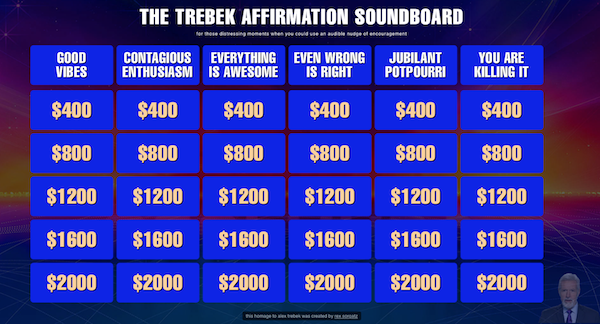
Finally, much of this post was inspired by the experience at this past week’s Task Management & Time Blocking Virtual Summit 2021, which I told you about in the Playing With Blocks: Success Strategies for Time Blocking Productivity. While the summit is over, you can still enjoy the educational experience at your own convenience if you purchase an All Access Pass.
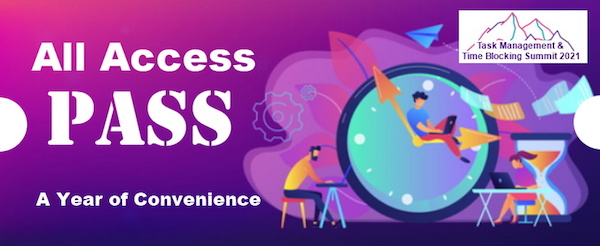
Organize Your Life: The Truth About Resolutions, Goals, Habits, and Words of the Year
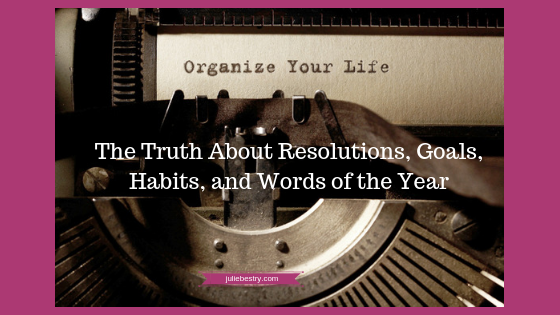
A new year begins and we give ourselves absolution for everything that has happened previously: our diets, our habits, our clutter. We have this vision that the true version of us isn’t reflected by everything we’ve ever been, but who we could become. Whether that mindset is more a matter of naiveté or positivity doesn’t matter as much as figuring out how we can transform this vision of who we want to be into a reality where we can say, this is who we truly are. So how do we get there?
RESOLUTIONS
New Year’s resolutions tend to come in two flavors. We promise ourselves we will change some behavior or personal trait (quit smoking, swear less, be nicer to our mothers, etc.) or accomplish some personal goal (run a 5K, learn Italian, knit a sweater). Making resolutions dates back ancient times. For example, the Babylonians apparently promised the gods they would return borrowed objects and repay debts. (Perhaps that resolution came from having achieved the prior year’s resolution to declutter, during which they found all the things they’d borrowed?)
In the United States, the ritual of making resolutions has actually increased over time, from about 25% of the population to over 40%. The biggest advantage I see in making resolutions is that it allows us to start the new year in a motivated, positive way – generally, at a time when the weather, our weights, our checking accounts, and our moods are fairly frightful. The disadvantage, however, is that most of us abandon our resolutions somewhere between February and June.
Resolutions tend to fizzle because of a few reasons: the real world (that is, the same things that kept us from maintaining our resolve last year) gets in the way, we haven’t identified working strategies for achieving our resolutions, or we have resolved to do something because we think we should rather than because we really want to do it.
If you’d like some inspiration for developing new or different resolutions, the Daring to Live Fully blog offers 29 New Year’s Resolution Ideas that go beyond the typical, with some motivational notions for volunteering, being more conscientious, and bringing more peace into your life. Lifehack has 50 New Year’s Resolution Ideas and How To Achieve Each of Them to help get you started. From adopting a pet to getting over an ex, there are enough choices to help you make this next year a little more interesting.
GOALS AND HABITS
Goals are the less shiny versions of resolutions. Nobody announces “New Year’s Goals” with a flourish or breathlessly asks celebrities about their “New Year’s Habits.” But goals provide a big-picture framework, and habits develop the muscles to accomplish those goals.
SMART goals are popular because they identify where resolutions and plans have might otherwise fail without precautions. SMART goals are supposed to be:
- Specific (What are you going to do? Use action verbs!)
- Measurable (What metrics will you use to show you’ve done what you said you’d do?)
- Achievable (Is this a practical goal? Is it realistic?)
- Relevant (Does this goal make sense for your life, family, or business?)
- Time-based (When will you start? When will you do the action? When will you repeat it? When will you finish? Remember, “Someday” is not a day on the calendar!)
You may want to lose weight, pay off debt, find a significant other, or grow your business, but the way to get there can’t be vague. Make sure your goals spell out what you’re going to do, how you’re going to do it, and how you’re going to measure your success.
Goals set the rules and create the game plan, but habits are how you get to the finish line. The reason you lose your keys all the time is because you don’t have a habit of always putting your keys in the same place every time you come home. (Or, I guess, you’ve got a hole in your pocket.)
Habits are settled or repeated tendencies. Bad habits become like second nature (which makes them hard to break). Luckily, good habits are hard to break, too! That means that if you can get in the habit, so to speak, repeating positive, healthy tasks, you stand a much better chance of achieving your goals.
Two superior resources for understanding how habits work, and how you can put them to use in your life, are:
Paper Doll’s NaNoWriMoMoMo (Novel Writing Month Monday Motivation)…Even for Non-Writers
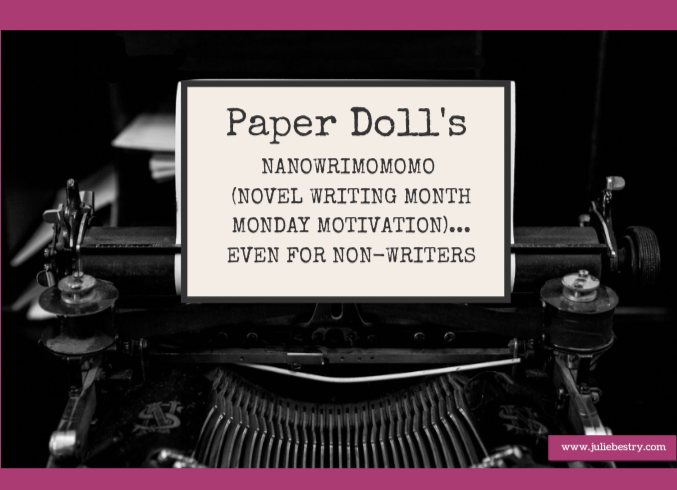
I always tell prospective clients that organizing isn’t about the stuff. It’s about the person who owns the stuff. That means that getting what you want out of the organizing process depends on getting what you want – a new set of behaviors – out of yourself. Whether you are organizing tangible things (your desktop and workspace, your home, your office) or organizing your time (work obligations, personal projects, family responsibilities, self-care), or organizing your thoughts (plans for the future, dialogue for your novel, deciding whether the other person loves you or just loves vanilla)…getting where you need to go depends upon organizing yourself.
But how do you get there? Last week, in Paper Doll’s How To Organize Yourself to Write for NaNoWriMo 2017, we talked about identifying your goals for writing, organizing your time, and charting your progress, but the truth is that motivation is an underpinning of all success.
In The 7 Secrets of Writing from the Best Writers in the World, Chad Grills collected advice about why to write as well as what to do to write better. My favorite quote from the article is from Steven King, who notably said, “Amateurs sit and wait for inspiration, the rest of us just get up and go to work.”
In my book, 57 Secrets for Organizing Your Small Business (for which I’m working on the second edition) I said that action precedes motivation. We all want the end result: we want to be fit, eat beautiful meals, have organized homes. Not many of us are super-jazzed to get up at dawn to head to the gym, shop and prepare for hours to make magazine-perfect dinners, or develop organizing systems. (Even we professional organizers have trouble getting motivated for our own projects!)
You know what motivates? Small victories! Sit down to write and notice that your word count gets to 500. Then you realize that you’re almost a third of a way to your daily goal of 1667, and you’ll be inspired to keep writing! Head to the grocery store with the recipe for that soup or appetizer whose magazine photo makes you salivate and bring home those ingredients – your investment of time (and money) will inspire you to start chopping! Waiting to be inspired to declutter your room might keep you waiting forever – start by picking up all the clothes that need to be hung, folded, or laundered and get them to the right place, and you’ll start to notice the momentum building.
Organizing a ritual helps, too. Many of my work-from-home clients have trouble getting started; there’s no clear delineation between being at home (lazing over coffee and Twitter, running a load of laundry, chatting on the phone) and the work day when there’s no supervisor peering crankily over the cubicle’s edge. Develop a ritual, whether it’s going out for coffee and then returning to work, or exiting via the garage door, walking around the block, and come back in the front door. It helps trigger that school-bell alert that it’s time to change tasks. Develop a ritual for when it’s time to sit down to write, and soon enough, like Pavlov’s dog, you’ll be conditioned.
There’s a writing ritual story, likely somewhat apocryphal, about Victor Hugo. It’s said that he had his valet take away all of his clothes, and left naked, he had no choice but to write, as he could not go out until his valet would reappear at the appointed hour. In other versions, he was left swathed head-to-toe in a huge knitted shawl, the 19th-Century version of a Snuggie or Slanket. Whatever the truth, without his ritual, the world may never have been graced with The Hunchback of Notre Dame or Les Miserables, meaning we might never otherwise have heard Wolverine (I mean, Hugh Jackman) sing “One Day More.”
Remind yourself why you’re doing this project and develop strategies that reflect your personality. I tell my clients that getting organized (or anything else we do) has to have more than a goal in mind. Knowing you want your living room, dining room, and kitchen to be clear of detritus may be the goal, but why? Is it because you’d like to invite friends over for coffee or dinner parties to keep the loneliness of the cold winter months at bay? Being able to socialize without obstacles or embarrassment is the motivation to keep working toward your goal.
So, just as we discussed last week, know why you want to write. Two recent organizing and productivity posts offer a little inspiration for thinking about your whys:
In Taking A Binge Approach to Organizing Projects in the now-defunct Unclutterer, Alex Fayle talks about the concept of binge projects (like NaNoWriMo and 30-day challenges) and compares the benefits. See what he has to say about creating overall goals, breaking down tasks, getting support, developing positive peer pressure, gamifying your approach, silencing your doubts, and achieving your results.
Meanwhile, Gretchen Rubin, author of such books as The Happiness Project, Better Than Before, and The Four Tendencies, looks at NaNoWriMo from the perspective of how to get from having a creative or entrepreneurial impulse to actually completing a project. In Signing Up for “NaNoWriMo”–National Novel Writing Month? Here’s Why It Works, Rubin looks at what it is about turning thought into deadline-oriented action that actually works for the Upholders, Questioners, Obligers, and Rebels (the four tendencies she’s defined and made famous). Rubin borrows from her own Better Than Before to see how habit strategies like convenience, monitoring, scheduling, loophole-spotting, and taking first steps can help you thrive and excel at NaNoWriMo (and other such challenges).
Finally, over at the blog for Reedsy, a publishing assistance platform, they’ve collected 41 Insider Tips for Winning NaNoWriMo 2017. My favorite tips are:
12. If you can’t block off a few hours each day, write in several shorter ‘sprints’.
In organizing, as in writing, too often people feel that if they can’t devote hours to a project then it is not worth attempting. But just as this article notes that you can use these sprints to get your creative juices flowing, you can do the same with your organizing.
In the five minutes you’re on hold with your credit card company, pull the expired spices out of your cabinet and make a list of what you need to replace. In the fifteen minutes before your favorite show comes on, go through two drawers in your dresser and move the sweaters you haven’t worn for a few seasons to the donation pile. And while you’re waiting for the water to boil for your pasta, open today’s mail, toss out all the exterior envelopes, move the bills to your bill-paying station, and shred those convenience checks and unwanted credit card offers!
16. ‘Perfect is the enemy of good.’ It isn’t exactly best friends with NaNoWriMo authors either.
Professional organizers tell our clients all the time: “Done is better than perfect.” If perfectionist procrastination is keeping you from starting a project because you fear it won’t be ideal when it’s done, then don’t aim for ideal. Just aim for done! Just as you can always edit and revise with writing, you can always modify your organizing systems, whether on your computer, in your paper files, or around your home.
40. Go through your manuscript and cut out all the words you don’t need.
Admittedly, timing is everything. For NaNoWriMo, you should write first, then edit. In organizing, it’s the opposite. Edit – cull, purge, pare down – whatever you don’t need, whatever you can find online (if it’s information), borrow from someone else (if it’s tangible), or cancel altogether (if it’s an obligation crowding you out of your schedule). Let it go.
I hope today’s post helped organize your motivation, whether you’re writing, decluttering, or working on any other kind of project.
Next NaNoWriMo Monday, we’ll be focusing on some tech tools to organize – whether you’re writing for NaNoWriMo, for work, or for academia. Meanwhile, I dare you to have read this whole post and not hum “One Day More” for the rest of your Monday.
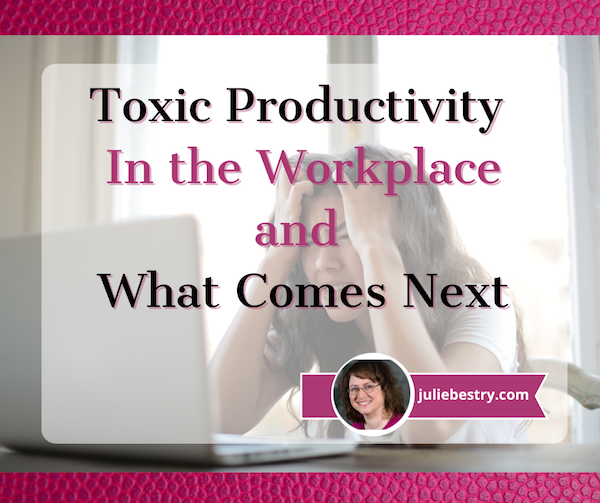




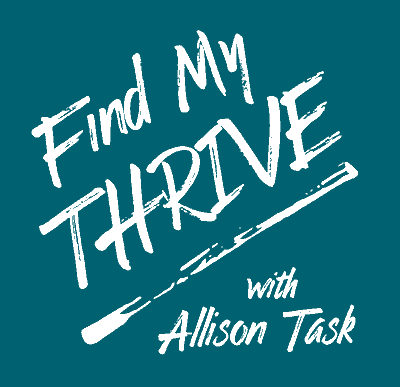






Follow Me